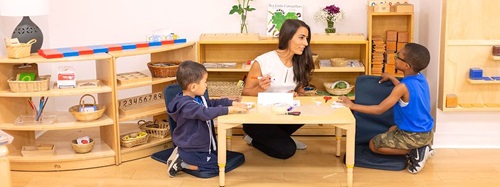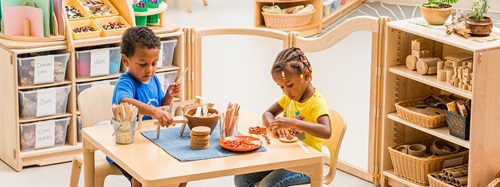The Challenge of Boys in Early Childhood Education
| August 2016I have a wonderful photo on my screen saver of my kindergarten class. They are playing in the Pennsylvania woods next to a large pond. The girls are playing together around a picnic table under a beautiful maple tree; the boys are all down by the lake. Actually, most of the boys are sitting on large boulders in the lake! And—most curiously—each boy has a stick in his hand. Some are fishing with them; others are using them to collect leaves, twigs, and other floating debris from the water.
While my kindergarten class does most things together, including growing a flower garden, caring for a group of laying hens, and playing outdoor games, the separation in this picture is very distinct. Further, while the girls are playing a distance from the water, the boys are actually in it, pushing safety and taking risks (and yes, I am very carefully supervising!).
Boys like to take risks. They love rough-and-tumble play, make lots of noise, and enjoy messing around with water, sticks, mud, and sand. They are spontaneous, impulsive, fun-loving, and mistake prone! But many young boys struggle in organized early childhood programs.
The Facts
- Boys represent 61 percent of kindergarteners held back from moving into first grade.
- While boys represent 54 percent of the preschool population, they represent 79 percent of preschool children suspended once, and 82 percent of preschool children suspended multiple times.
- Boys are almost 5 times more likely to be expelled from preschool than girls.
- Boys are 2 to 4 times more likely to be identified with a learning disability (the largest of the federal special education categories) than girls.*
- ADHD is diagnosed 3 to 4 times more often in male compared to female students.*
Goodness of Fit
The work of Thomas and Chess (1977) introduced the concept of "goodness-of-fit". This is an idea which shows that, for optimal development, a match must be created between a child’s temperament and their social environment.
This match is a pattern of social interactions between the child and his caregivers (Berger, 2003). Thus parents, child care providers, and teachers need to be in tune with each child’s idiosyncratic temperament. This goodness-of-fit is critical for the child’s future emotional, cognitive, physical, and social development.
It is now clear that the idea of goodness-of-fit goes well beyond temperament, and must include a close match between all of the young child’s developmental needs and their social and physical environments. And it is clear that many programs do not provide this goodness-of-fit for our young boys.
There are a number of reasons many young boys struggle in early childhood programs. Some of these include:
- In general, the development of boys’ brains and overall nervous systems is delayed compared to girls (Berk, 2002; Leaper, Anderson & Sanders, 1998). And, since the brain controls cognitive development, attention, and emotional regulation (the ability to control one’s own behavior), this delay directly impacts attention span, activity levels, and overall academic development. Boys’ impulsivity and poor self-regulation are directly tied to their immature brain development.
- The curriculum and activities in most early childhood programs focus on literacy activities, the arts (often more crafts), and social-dramatic play, along with behaviors deemed necessary to achieve these activities. It is well known that young girls’ verbal skills surpass those of young boys (Owens, 2012). Boys prefer wild, aggressive, full-body activities, constructive play, hands-on learning with concrete materials, and lots of movement. They also seem to love to make a mess!
- The current push-down of K-12 curricula expectations, along with unrealistic behavior expectations, has resulted in more and more boys struggling to meet academic standards. As a result, a disproportionate number of boys are being expelled, suspended, or placed in special education.
- Because of the focus on meeting academic, school-related standards, “school readiness” early childhood programs focus their budgets and teacher training on literacy programs, technology, countless assessments, and classroom management, as opposed to well-equipped playgrounds, indoor gross motor rooms, in-depth projects, and a variety of field trips.
- Early childhood programs, in general, provide a goodness-of-fit between all aspects of the program (curriculum, activities, involvement of teachers) and the needs of girls. Almost all staff in programs for young children are women
- We have created a fix the child syndrome (as opposed to change the program). Early intervention approaches, multiple assessments, and a focus on what is considered normal development, have led to a need to identify and label children who struggle in our programs. This in turn has led both to a belief by these children that they cannot succeed, and that the program selects winners and losers (Kohn, 1993).
Solutions
Some of the suggested solutions can be met in the ways we interact with children, choose activities, teach our children, structure our classrooms, and schedule the day. But others will require systematic changes in the entire early childhood field—at least in the United States.
The first, and most important, change to be made is to fully recognize that, in some fundamental ways, young boys and young girls are different, which means they must be treated differently (goodness-of-fit). This does not mean inequality; as every parent knows, treating each of their children exactly the same is a formula for disaster! We must not confuse sameness with equality. Other suggestions include:
- Radically reevaluate our focus on outcome standards. Standards for quality program performance are fine; outcome standards, especially academic and behavioral standards that are not developmentally appropriate for all children, are a huge problem, especially for many boys. We need to go back to a true understanding of developmentally appropriate practice (Wardle, 1999); we also need to take lessons from countries like Finland, where quality early childhood programs do not sacrifice developmentally appropriate practice.
- Shift the overall focus of early childhood curricula and activities to hands-on experiences, whole body physical activities (inside and outside), whole-child learning, and developmentally appropriate science and mechanical projects; return play to the center of the curriculum, and use flexible daily schedules with large blocks of time. A variety of in-depth projects should also be incorporated into the curriculum.
- Embrace the natural variability of the development of young children. There is a tendency to view average developmental trends as milestones, which of course penalizes children who are naturally behind in one or more domains. Further, a vast variety of approaches need to be tried before referring a child to be screened for possible special needs. These approaches include working closely with parents, changing the curriculum, differentiating activities, using different learning styles to perform a task or activity, and so on.
- Never withhold activities a child enjoys doing, and is competent in performing, as an incentive to complete an activity or task a child struggles with (the Premack principle). All children—but especially those who struggle, both academically and behaviorally—need lots of opportunities to be successful, even if it’s simply playing on the playground or painting a fantastic picture (Erikson, 1963).
- Increase the number of men in early childhood programs. This is one of those long-term systemic challenges requiring; 1) increasing the number of fathers, grandfathers, older brothers, and community volunteers in our programs, and 2) a paradigm shift both in terms of our culture’s view of men (nurturing, supportive, emotional), and society’s view of men’s ability to care for young children.
- Make classrooms more boy-friendly. Provide a woodwork center; redo the dramatic play area (drop the term housekeeping); carefully select books on subjects of interest to boys; and make sure there is lots of time every day for a variety of outdoor activities, including exploring nature. The dramatic play area needs to include props such as hard hats, brief cases, tools, fire fighter hoses, police uniforms, sports hats and uniforms, etc. Books need to include heroes, monsters, construction, vehicles, huge earth-moving machinery, messy activities, and so on.
Many boys struggle in our early childhood programs. This is evident by the disproportionate number of young boys who are suspended, expelled, and/or placed into special education programs. This is no accident. To address these discrepancies, a variety of approaches need to be taken, from radically changing some fundamental practices of the field, to adjusting the curriculum, activities, environments, and teacher-child interactions.
* These statistics are for children 6 years and older, because we don’t have statistics for children under age six. One can only assume these figures would be even higher for young boys! (Cortiella, 2011; Gilliam, 2005; Lerner & Johns, 2012; U.S. Centers for Disease Control and Prevention, 2013; U.S. Department of Education, Office of Civil Rights, 2016).
Berger, K. S. (2003). The Developing Person. Through Childhood (3rd ed.). New York: Worth Publishers.
Berk, L. A. (2002). Infants and children. Prenatal through middle childhood (4th ed.). Boston, MA: Allyn & Bacon.
Centers for Disease Control and Prevention (2013). Attention Deficit Hyperactive Disorder: Data and Statistics. Retrieved from http: //www.cdc.gov/ncbddd/adhd/data/html
Cortiella, C. (2011). The State of Learning Disabilities. New York: NY: National Council for Learning Disabilities.
Erikson, E. H. (1993). Childhood and society (2nd ed.). New York: NY: Norton.
Gilliam, W. S. (2005). Prekindergarteners Left Behind: Expulsion rates in state prekindergarten systems. FCD Policy Brief Series 3. New York: Foundation for Child Development.
Kohn, A. (1993). Punished By Rewards: The trouble with gold stars, incentive plans, A’s, praise, and other bribes. New York: Houghton Mifflin.
Leaper, C., Anderson, K. J. & Sanders, P. (1998). Moderators of gender effects on parents’ talk to their children. A meta-analysis. Developmental Psychology, 34, 3-37.
Lerner, L. & Johns, B. (2012). Learning Disabilities and Related Mild Disabilities (11th ed.). Belmont, CA: Wadsworth/Cengage.
Owens, R. F. (2012). Language Development: An Introduction (8th ed.). Upper Saddle River, NJ: Pearson.
Thomas, A. & Chess, S. (1977). Temperament and Development. New York: Brunner/Mazel.
U.S. Department of Education, Office of Civil Rights (2016). Civil Rights Data Collection. Data Snapshot: Early Childhood Education. Washington, DC: U.S. Department of Education.
Wardle, F. 1999). In praise of developmentally appropriate practice. Young Children, 54(6), 4-12









